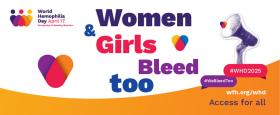VWD, Basically
Cynthia Gauger, MD, pediatric hematologist at the Nemours Children’s Clinic in Jacksonville, Florida, covered a lot of ground during the July 21 afternoon session, Basics of VWD. Getting diagnosed and treated are not as straightforward for people with von Willebrand disease as they are for those with hemophilia. “Unfortunately, there is not one simple test to test for it,” Gauger said. “A lot of people with VWD have mild symptoms, and can be overlooked.”
VWD AND YOU
Von Willebrand factor (VWF) circulates with factor VIII (FVIII) in the blood plasma. It binds to platelets, keeping them in place to help form a platelet plug, helping a wound heal. But if it’s partially or completely deficient (not enough is produced) a person winds up with type 1 or type 3 VWD, respectively. If VWF is defective (it’s not working properly), a person can have type 2 VWD. It has 4 subtypes: 2A, 2B, 2M and 2N. VWD is not a respecter of persons—it occurs equally in men and women. Symptoms range from mild to moderate; some, such as gastrointestinal (GI) bleeds, can be life-threatening.
Gauger listed some of these hallmarks of VWD:
Frequent, prolonged nosebleeds lasting 10 minutes or longer
Excessive bruising, with raise lumps
Bleeding from minor wounds, lasting 15+ minutes
Heavy, prolonged, recurrent bleeding in the mouth and/or gums after dental extractions and surgery
Blood in the stool
Anemia requiring transfusion
Heavy menstrual periods with blood clots exceeding 1” in diameter’ changing a pad or tampon hourly or more often
LAB TESTING, AGAIN
“Lab testing is a frustration for everybody,” Gauger said. That’s because everything from blood type (type O has lower levels), exercise, illness, inflammation, surgery and pregnancy can cause VWF levels to rise to normal values. “A child who is struggling, crying and anxious can transiently elevate VWF and FVIII levels,” said Gauger. Further, how samples are handled and processed can skew results. “They have to be kept frozen and remain frozen until they’re analyzed,” Gauger stressed. She went through a slew of tests that help diagnose patients. Gauger encouraged patients and parents to get copies of the lab reports and read through them.
TREATMENT STRATEGIES
There are three general strategies for treating VWD, said Gauger:
1) Using DDAVP to release the body’s store of VWF, making it available.
2) Replacing VWF with plasma-derived, virally inactivated concentrates (four now on the market). Gauger also mentioned the recent FDA approval of the first recombinant product to treat VWD. “This is really exciting,” she said. “We’re making progress here.”
3) Promoting wound healing via clot stabilizers called antifibrinolytics.
There are also topical products to seal wounds, keep clots in place and stop nosebleeds.
MORE CHOICES
Not all products are effective for everyone, but it’s good to have choices. “There are pros and cons to recombinant and plasma-derived products, so talk to your provider” Gauger said. “The more you know, the more you can advocate for yourself.”
Note: This article was originally published in the NHF Daily and written by Sarah M. Aldridge, Manager of Editorial Services.
About The Author
You May Also Like

On April 17th join us to celebrate World Hemophilia Day and raise awareness about hemophilia and…
Share your voices, stories, artwork and videos.
